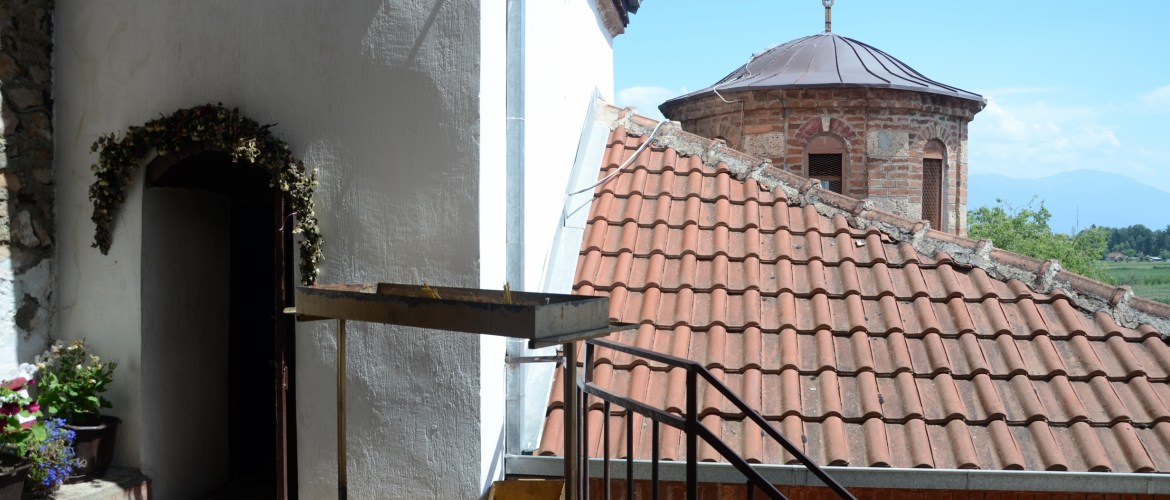Saint Erasmus in Ohrid

On the road leading to Ohrid, in front of the very entrance to the city, stands a small, modest board bearing the inscription “Saint Erasmus”. It points to the eponymous 5th century three-nave basilica dedicated to this saint, who is one of the 14 saints-helpers in trouble. Besides this one, there is another church nearby, a small cave church dating from the 13th century, and his portraits can be found not only here but also in the church “St. John the Theologian – Kaneo”, where he is represented next to St. Clement, the protector of the city.
The date of his birth is not known. As a young man he became bishop of Antioch. Diocletian referred to him as young and beautiful, but he tormented him because of his faith in Christ. The Macedonian Slavic tradition ascribes him certain missionary activities for a period of nearly ten years (293-303), naming him the first and true missionary in Ohrid.
We learn about his life from two hagiographies dating from the 9th and 11th century and describing his coming to Lihnidos at the end of the 3rd century, carried on the wings of the angel who rescued him from Diocletian’s (284-305) tortures in Antioch. The angel led him out of the terrible darkness and took him to the City of Light, where he immediately started preaching the Gospel of Christ and performing numerous miracles: he restored sight to the blind, and healed those suffering from various illnesses.
“… There was a certain noble and prominent citizen in the city, named Anastas, whose son had been lying dead, and they carried his body to be buried. Coming to his grave the blessed one said: ’Anastas, if you believe in the Lord Jesus Christ, born of the Holy Ghost and the Virgin Mary, He shall bring your son back’. Then, kneeling over the body, he shouted in a strong voice: ‘Rise, little child!’ Before this voice, the child resurrected and shouted in a loud voice: Great is the Lord of the Christians!’ And so Anastas believed and his entire family believed, because in that moment 40,000 of the people present were baptized. And the Lord blessed His people who believed that day, and in the days to come. And St. Erasmus didn’t stop teaching God’s people for seven whole days…”
When the emperor Maximilian found out about this, he called him to come to Sirmium in order to be punished, but before that he showed him the great copper statue of Zeus, 12 cubits high, wanting him to bow to it. But the moment Erasmus looked at the statue it collapsed and turned into dust… 30,000 of the people present that day were baptized, but the emperor ordered for them to be executed, and St. Erasmus to be punished by dressing him in heated copper clothing. Hearing this St. Erasmus began to sing: ‘We have passed through fire and water, yet you led us again to blessedness… ‘The heated clothing immediately chilled like snow…” The Angel again rescued St. Erasmus by taking him to Durres, from where he traveled safely by boat to Formia, Italy. Seven days later (June 2, 303) he died exhausted by exertion and torture, and for all this he is honored as a martyr. After this city was destroyed in the 9th century, his remains were moved to Gaeta.
And so, Erasmus became the universal patron of all sailors (he was honored in Italy, France, Spain and Portugal) and his symbol was a spool with a rope wound around. Pictures can be found in Belgium and Germany representing the saint with his stomach torn out, because he was considered protector against stomach and labor pains. In many regions he is also honored as protector against cattle diseases and epidemics, and in others as patron of the miners and turners as well.
We find proof that he existed, preached Christianity, performed miracles and was a martyr in his hagiographies. His cult has been well-kept in Ohrid since the time it was called the City of Light (Lihnidos). That is why he will forever remain known as St. Erasmus of Lihnidos.

